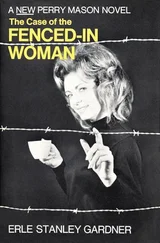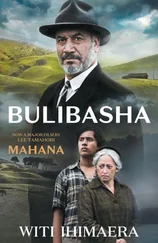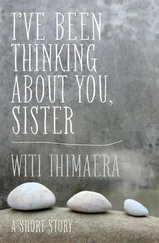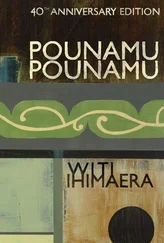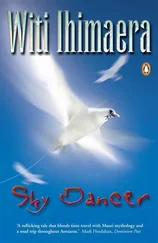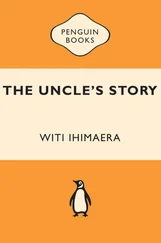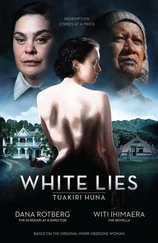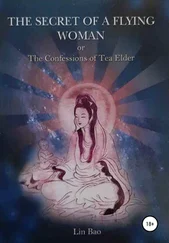‘May I have some of the cool, sweet water that you carry from the stream?’ the young man asked.
Erenora could not look up at first; she knew immediately that the stranger was Horitana, and her heart leapt because he was still alive and had finally returned home. Thank goodness, as he had a price on his head for fighting with Titokowaru. However, when she appraised Horitana her heart sank. Although there was some sadness about him, he still had his shining eyes and he was so handsome now, and, well, her sisters had always been the attractive ones — surely he’d be more interested in them. His hair was thick, long and matted, and he looked as if he’d been walking for years. Across his back was a haversack and slung in a pouch across his chest was an Enfield rifle; it was a sharpshooter’s weapon, now his favoured gun, which he had looted from a dead British soldier.
Heartsick, she nodded. ‘Yes, you may have some water.’ She didn’t even bother to try to push her hair back or wipe the sweat from her brow. What would be the use? She gave him the dried pumpkin shell.
The tataraki’i pressed closer, wanting to look at Horitana’s rifle. ‘’aere atu,’ Erenora said to them. She began to motion them away and would have followed except that Horitana reached out a hand and stopped her.
‘No, don’t go,’ he said. Despite his war-weary appearance, he was attentive and polite. ‘It would be even nicer if your lovely hands would tip the calabash so that the sweet water can pour between my waiting and eager lips.’ His voice was low, thrilling and slightly teasing.
Erenora had never liked being addressed in such a familiar manner, so she said petulantly, ‘I do no man’s bidding! Tip the shell yourself or ask one of the other women to do it for you!’ Ripeka would have loved to do that .
Horitana didn’t take offence. Instead he laughed, ‘Don’t be angry with me.’ In a softer tone he said, ‘I haven’t had the opportunity in my life to know what is appropriate to say to women, and what is not.’
Erenora gave him a look of acceptance. She watched as he lifted his face, opened his mouth and held the calabash above it. Some of the water splashed down his neck. If he only knew how she wanted to lick the water. And the masculine smell of him: it was like the musk of the bullocks.
For a while, there was silence. Then Horitana coughed. ‘You waited for me?’
‘For someone who has a reward posted for him?’ Erenora retorted, her usual sense of independence returning. ‘Maybe I have, maybe I haven’t. And you should know better than to bring a rifle into Parihaka.’
His eyes clouded, as if the memories of the wars were painful to him. Then he looked her up and down. ‘You’ve grown as tall as me,’ he said, as if that were a problem, ‘and you sound very proud. Perhaps I should reconsider the plans that have always been in my heart to make you mine.’
He had the gall to wink at Ripeka in Erenora’s presence. Ripeka was lapping it up.
‘Alas,’ he sighed, ‘I am a man of honour …’
‘You had better be!’ Erenora said. Was he deaf? Could he not hear the loud beating of her heart: ka patupatu tana manawa? ‘As for my height,’ she continued, ‘the problem is easily solved … you must get used to it.’
Of course Ripeka was jealous but, really, she was never in the running.
Erenora was finally reunited with the orphan boy she had always loved, but she wasn’t an apple that fell too readily off a tree. Yes, she was proud and she knew her own worth. Horitana would have to do much more than simply profess his love to win her.
After a suitable time of wooing, throughout which Huhana was a vigilant duenna, Erenora and Horitana finally tied the knot. Although it was difficult to retain her virgin status in the face of Horitana’s persistent ardour, she was a virgin when she married him; he was twenty-two.
Te Whiti himself presided over their wedding and led them to their marriage bed.
‘My love for you is like a cloak of many feathers,’ Erenora said to Horitana. ‘Let me throw it around your shoulders.’
His voice was full of gratitude. ‘Erenora …’
‘And now, let me plait and weave the flax of our desire into each other’s heart and tighten the tukutuku so that it will never break apart.’
This time, Horitana’s voice flooded with urgency. ‘ Erenora .’
PARIHAKA.
Taranaki Prov. Locality in Egmont County. Farming. Twenty-six miles south-westward by road from New Plymouth. Access by side road from a turn-off three-quarters of a mile below Pungarehu. About two miles eastward from the main highway between Pungarehu and Rahotu. This village, now a curious mixture of the ancient and modern, was once a celebrated Maori centre, but is chiefly remembered as being the headquarters of Te Whiti and Tohu, who taught the doctrine that the Maoris were Israel and that the British were Pharaoh and the Egyptians who enslaved Israel … Name means, perhaps, ‘Dancing on the cliff ’.
I quote from The New Zealand Guide , published by H. Wise, noting the date: 1962. Up to the mid-1960s, when I was studying at training college, there was very little mention of Parihaka at all: G.W. Rusden’s History of New Zealand (1883), James Cowan’s The New Zealand Wars (1923) and then thirty years of virtual silence until Dick Scott’s booklet, The Parihaka Story (1954), and Bernard Gadd’s 1966 article on Te Whiti in the Journal of the Polynesian Society .
Erasure from the official histories and memories seems to have been the order of the day. With some disgust I record that the first edition of the New Zealand government’s Descriptive Atlas of New Zealand , published in 1959, went as far as to expunge Parihaka entirely and overprint it with a Pakeha name.
I wouldn’t be surprised, therefore, if you haven’t heard of Parihaka or its remarkable history. From the very beginning, Te Whiti and Tohu practised conciliation, and in Parihaka they set up a kainga on land which they truly believed the government had acknowledged as theirs. They also went one step further and set themselves up as negotiators for the return of other lands in Taranaki that had been confiscated without proper legal basis.
This is my interpretation, of course, and the situation on the ground is murky only because the Pakeha made it so. For instance, despite the New Zealand Settlements Act, the Crown didn’t exercise ownership over the great tract of land that amounted to almost half of the Taranaki Bight.
Let’s look at a map of the time as that might show more easily what Pakeha occupied as Te Karopotinga o Taranaki continued, and what, for want of a better description, was still Maori territory. This is the Taranaki Bight, ne? Josie will dislike my comparison with a woman’s breast but think of the top side of the right breast at the armpit as the location for the Stoney River. Now draw a line across the breast, across the top part of the nipple, Mount Taranaki, like so, and continue it down to the centre of the chest to this place, the Waingongoro River: all the land to the north-east of the line was in the process of being taken by the Pakeha. But all the w’enua, the land to the south-west, was still ours! Indeed, ex- rebels had been allowed to return to it, and an area of 70,000 acres given back. Surely this was a sign that the government was honouring the prior ownership of this territory by Maori?
And here, immediately west of the mounga, was Parihaka and the land that became known as the Parihaka Block. Within, as it were, a demilitarised Maori zone. Indeed, some people say that Te Whiti actually told Robert Reid Parris, the government’s land purchasing agent, in words that brooked no argument, ‘You stay behind.’
Читать дальше

